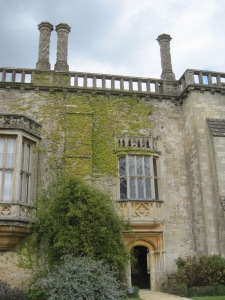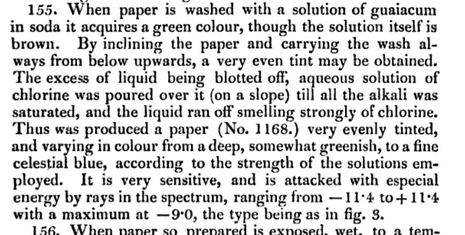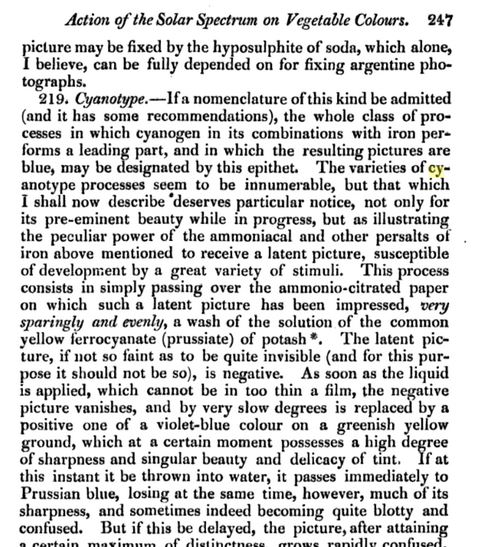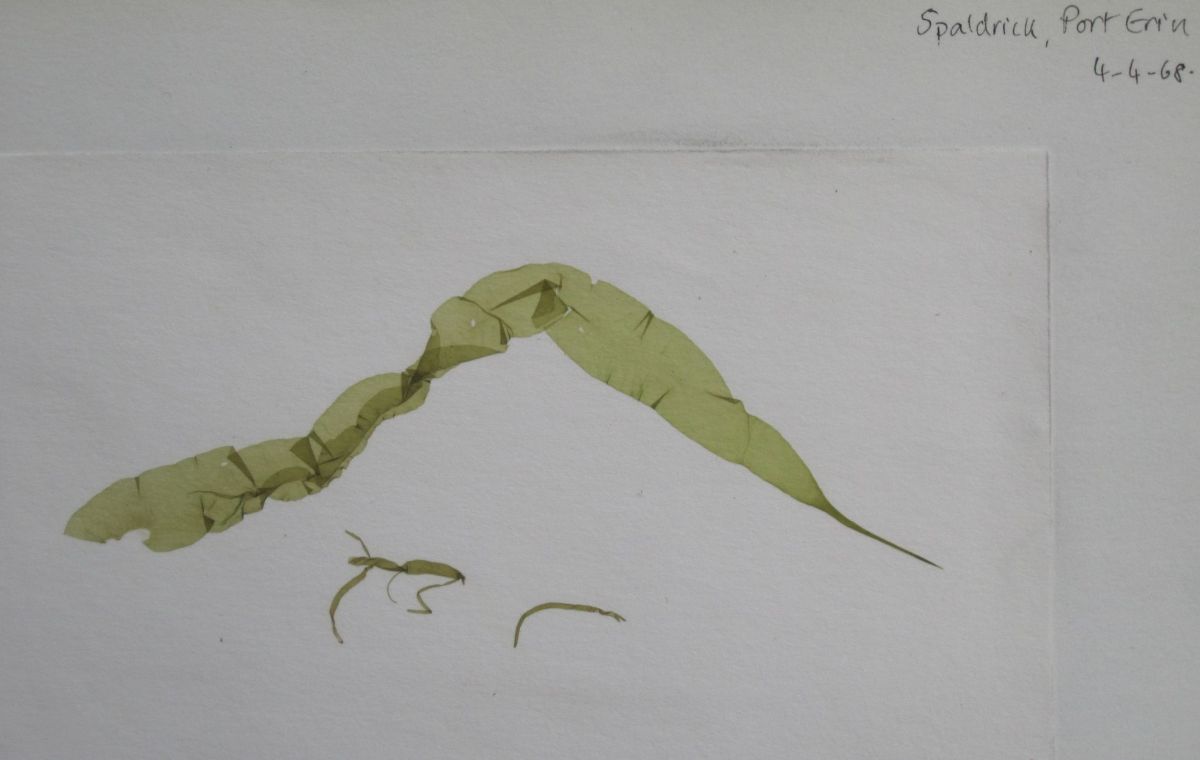When I was an undergraduate, I collected these green and red algae on a London university field trip at Liverpool’s former Marine Laboratory at Port Erin, Isle of Man. We were shown how to float the more delicate species onto white card; large polysaccharides like alginate and carrageenan would be released from the cells, swell as they hydrated, and bind the fronds onto the card as the specimen dried. After all these years the algae have kept their colour and shape. Larger, thicker algae like the brown Fucus species common on rocky shores, were pressed and dried.
Collecting seaweed and displaying it in albums was one of the ‘sea-shore pleasures’ that entertained the Victorian middle classes. Ladies were not expected to be scientific in their collecting but, rather, to arrange their seaweeds in an aesthetically pleasing and artistic manner; the making and displaying of scrapbooks was a parlour pursuit, art rather than science.

(Collecting sea-anemones – actinia – and keeping them in marine aquaria was another craze, inspired by Philip Henry Gosse’s Actinologia Britannica (1860): so much so that he was to bewail, ‘They have swept the shore clean as with a besom!’)
Amelia Griffiths (1768-1858), the widow of a clergyman, had become singularly knowledgeable about seaweeds. From her home-base in Torquay she collected along the Cornish, Dorset and Devon coasts. According to Philip Strange’s fascinating blog-post, “she helped male seaweed enthusiasts in producing scholarly studies on the larger and smaller seaweeds, generously giving her knowledge and donating samples.” Amongst the men was the Irish botanist William Henry Harvey (1811-1866) who went on – with Mrs Griffiths’ help – to produce his handbook of British Marine Algae, followed later by the 3-volume Phycologia Britannica, illustrated with coloured plates, and published in 1846.
According to Philip Strange, Mrs Griffiths was often helped by her maid Mary Wyatt – who later ran a shop in Torquay selling shells and other seashore memorabilia to visitors, and who was encouraged by Harvey “to sell books of pressed and named seaweeds to help identification. Supervised by Amelia, she produced the first two volumes of Algae Danmonienses (Seaweeds of Devon) by 1833. Each volume contained 50 species …”
As an aside here, Philip Henry Gosse must surely have come across the elderly Mrs Griffiths (she lived to the age of 90) during his early sojourns on the Dorset and Devon coasts, during his own expeditions to collect and identify marine animals for his marine aquaria.
This was a time when science, in terms of enquiry, knowledge and new techniques, was advancing quickly. Scientists (‘natural philosophers’) knew of each other and, if they had been appointed members of prestigious establishment institutions such as the Royal Societies of Edinburgh or of London, they were sure to meet and talk and correspond.
At the same time as Harvey was working on the accurate representation of British seaweeds through coloured engravings, lengthy papers and postcripts and addenda were being presented to the Royal Society on other methods of capturing images, on paper or metal plates that had been made sensitive to light.

William Henry Fox Talbot was developing a method of recording images as negatives on high-quality paper sensitised with a solution of silver iodide, which became known as the ‘Talbotype’ or calotype process.
At the same time, the astronomer and chemist John Herschel (1792–1871), who – like many natural philosophers of the time – had wide and eclectic interests, had been testing the effect of the spectrum of light in changing the colours of plant extracts. He presented his findings to the Royal Society in a lengthy paper “On the Action of the Rays of the Solar Spectrum on Vegetable Colours and on Some New Photographic Processes,” on June 16 1842, with a postscript added in August.
As well as using extracts of various flowers, he also used a solution of the gum guaiacum, and experimented with the effect of chlorine gas and solutions of salts of chlorine, iron, ammonium and more.

He began to home in on the underlying chemistry and the best methods of producing – and fixing – the colour change of the pigments on exposure to sunlight, and to use this to produce negative images of objects placed upon the sensitised paper: a process he called cyanotype.

Rather than plant extracts, with their cocktail of constituents, he sensitised paper with a mixture of iron salts, ferric ammonium citrate and potassium ferrocyanate. Exposure to sunlight produced a background of ‘beautiful and pure celestial blue’ – Prussian Blue – around the object that was being recorded.
John Children was Keeper of the Department of Zoology at the British Museum from 1837-40, and was also a chemist and an entomologist. He too was a Fellow of the Royal Society and served as its Secretary from 1830-37. Naturally, he knew Fox Talbot and John Herschel; indeed, they were friends, and along with other scientists such as Humphrey Davy, visited his home – with its well-equipped laboratory – in Kent.
Children’s wife Hester had died soon after giving birth to their daughter Anna in 1799, and it seems that Anna later “received an unusually scientific education for a woman of her time”
In 1825 she married John Pelly Atkins, a London merchant, and they moved to Halstead Place, the Atkins family home in Sevenoaks.

Atkins was also acquainted with Fox Talbot, and so, through her husband’s and her father’s friends, Anna learnt about calotypes and cyanotypes, the new techniques of photography.
At the same time as William Harvey was being helped by Amelia Griffiths, Anna Atkins too began recording the variety of British seaweeds, but using Herschel’s photographic technique of ‘blueprinting’ or cyanotyping; she placed pressed algae under glass on paper that had been sensitised with a mixture of soluble iron salts, and exposed them to the sun. After washing in water, the background colour deepened to a uniform ‘celestial blue’, leaving the detailed outline of the algae in grey; washing, then drying, fixed the colour and the image. Since the object was placed directly onto the paper, these were strictly cyanograms.
Between 1841 and 1853, Anna produced the several parts of her Photographs of British Algae: Cyanotype Impressions, each of which contained around 400 images. It is not known how many copies she made but fewer than 20 still survive, all slightly different, and those at the British Library and the New York Public Library have been digitised and made available online. Inside the NYPL’s copy is the hand-written inscription, ‘Sir John F W Herschel, Bart. With Mrs Atkins’ compliments’. It is even possible to download a Kindle version (in shades of grey) from Amazon.
(All these images are from the New York Public Library’s digitised version)
Much of her work after 1853, such as the beautiful Cyanotypes of British and Foreign Ferns , was made in collaboration with her lifelong friend, Anne Dixon (1799-1864), a second cousin of the writer Jane Austen.
‘Bloom’
I belatedly came across Anna Atkins’ cyanotypes when my daughter Rachel gave me a copy of the Horniman Museum’s publication, Bloom, related to the exhibition by artist Edward Chell. In 2011 one of theHorniman’s librarians discovered that ‘in the darkness of the archives’ of the collections were folios of a rare and valuable copy of Atkins’ British Algae: Chell’s work during his residency at the Museum was inspired by the cyanotypes as a way or representing plants.
The technique
Atkins’ cyanotype ‘photographs’ are so striking because the background is so even in colour, and the outlines of even the most delicate algae are shown in such fine detail.
I already have a small collection of pressed seaweeds; I take people on low-tide walks on the Solway shore where we wander amongst weed-covered rocks; Rachel and I for several years developed and printed our own black-and-white photos; there is plenty of information about the cyanotype technique online (the Alternative Photography website is especially useful) … The technique is reputedly ‘simple’ – so of course I had to try it.
Basically, just two iron-containing chemicals are required: potassium ferricyanide and ferric ammonium citrate. Make them up separately – Solution A: 25 grams Ferric ammonium citrate (green) and 100 ml. water; Solution B: 10 grams Potassium ferricyanide and 100 ml. water – and mix in a non-metallic container.
Then – in dim light – paint the mixture onto paper using a soft, broad paintbrush (without a metal ferrule); leave the paper to dry in the dark; place your object or negative on the sensitised paper, preferably under glass to flatten and hold it in place, and expose to sunlight until you see the outline of the object.

The pale green-yellow of the sensitised paper darkens towards blue in the sun, but is unchanged beneath the object. In bright sunlight the image develops within a few minutes but on a duller day it takes longer – and during a longer exposure the sun moves, so the outline of the object becomes fuzzy.
Wash in cold water for about 10 minutes until no greenish-yellow colour washes out (the startling Prussian Blue colour develops most strongly during washing) – and hang up to dry.
In the first step of the reaction, ferric (FeIII) ions from the soluble ferric ammonium citrate are reduced in a photochemical reaction, by UV in the sunlight, to ferrous (FeII). In the second stage, these ferrous ions then react in a complex way with the ferric ions in the potassium ferricyanate.
The result is an insoluble, dark blue compound – ferric ferricyanate – or Prussian Blue.
3Fe2+ + 2Fe(CN)63- → Fe3 (Fe(CN)6)2
After exposure, the colour is brought out further by oxidation during washing in tap water (dilute hydrogen peroxide can also be added).
Results
My first attempt, using leaves and seeds from the garden, worked astonishingly well, and I was thrilled with the colour; it was either ‘beginner’s luck’, or else the marine algae really are more difficult.
To make such fine and accurate prints as Anna Atkins’, with a uniform background colour, will require more experimentation, but I have been pleased with the results so far, and I’m enjoying the challenge. Each attempt shows me new variables that need to be controlled. Unfortunately I can’t control the amount of sunshine!
I’ve experimented with different papers, with different ways of coating them, with different ways of arranging the algae, and with different washing-times.
Careful arrangement of each specimen on the paper with forceps before lowering the glass is tricky – but important.
I’ve learnt that thick seaweeds, even after pressing, may throw shadows that blur the edges. With very delicate algae, or colonial animals like hydroids, the finer details often appear during washing.
Art meets science: different points of view
Anna Atkins’ cyanotypes of marine algae and British ferns are a mixture of artistry and science, which she intended to be used as an aid to identification.
Mine cannot yet be used for accurate identification of species, but I’m enjoying the multifaceted approach: cyanograms, photographs of fresh specimens, pressed and dried specimens, and algae that have been floated onto card and dried.
There is the possibility to play with different ways of recording shape and colour.
There is the possibility to gain different perspectives, and to hint at different points of view.

























